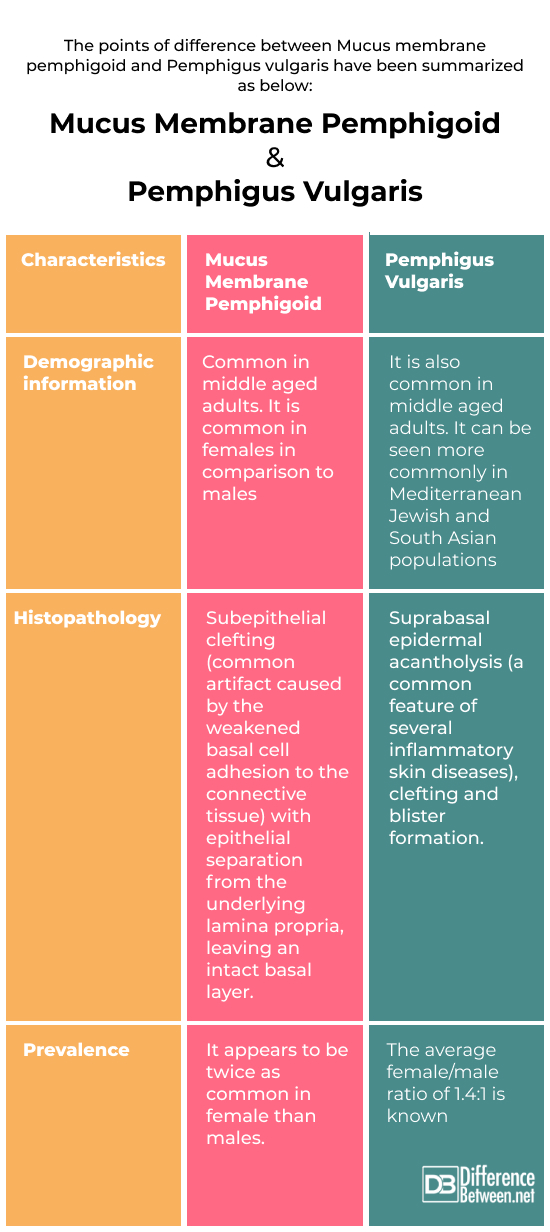Difference Between Mucous Membrane Pemphigoid and Pemphigus Vulgaris
A set of uncommon chronic (persistent) autoimmune (our immune system attacks the healthy cells of your organs and tissues by mistake) blistering disorders that mostly affect the mucous membranes, especially the conjunctiva (inflammation of the outer membrane of the eyeball and the inner eyelid), and sporadically (occasionally or at irregular intervals) the skin is referred to as mucous membrane pemphigoid (MMP), also known as cicatricial pemphigoid.
A rare class of autoimmune disorders includes pemphigus (a rare group of blistering autoimmune diseases that affect the skin and mucous membranes). On the skin (the peel or outer layer) and mucous membranes all over the body, it results in fluid filled cysts – blisters. The lips, nose, throat, eyes, and sex organs – genitalia may all be impacted. The most typical category of pemphigus is called pemphigus vulgaris.

Mucus membrane pemphigoid
An autoimmune condition known as mucous membrane pemphigoid (Cicatricial Pemphigoid) causes blistering lesions (fluid-filled bubble) on the mucous membranes. The conjunctiva (a mucous membrane covering the inner surface of the eyelids and the outer surface of the eye) and oral mucosa (the lining of the mouth) are two places that are frequently affected. The esophagus (elongated organ of the digestive system which connects the pharynx to the stomach), trachea (windpipe), genitalia (the organs of the reproductive system), and nostrils are additional regions that could be impacted. On the face, neck, and scalp, there might occasionally be blistering lesions (fluid-filled bubble) due to skin involvement.
Oral pemphigoid and cicatricial pemphigoid are other names for mucous membrane pemphigoid.

Pemphigus vulgaris
A rare class of autoimmune disorders includes pemphigus (a rare group of blistering autoimmune diseases that affect the skin and mucous membranes). On the skin (the peel or outer layer) and mucous membranes all over the body, it results in fluid filled cysts – blisters. The lips, nose, throat, eyes, and sex organs – genitalia may all be impacted. The most typical category of pemphigus is called pemphigus vulgaris.
Difference between Ramsay hunt syndrome and shingles
Definition
Mucus membrane pemphigoid
It is a pemphigoid and a rare autoimmune subepithelial blistering and scarring disease which involves mucous membranes and dermis by erosive lesions
Pemphigus vulgaris
Pemphigus vulgaris is a chronic immune system disorder that affects a small percentage of people. Blisters become visible on the dermis and in the mouth as a result. Although medication can help control it, it can be quite serious.
Symptoms
Mucus membrane pemphigoid
The main sign of mucous membrane pemphigoid (MMP) is the onset of painful blistering (cysts) that results in the breakdown (collapse) of the mucous membranes followed by inflammation, redness, and swelling that finally result in ulcers. These open sores may cause scars (a mark left on the skin after a wound or injury has healed) in the affected area as they heal.
Pemphigus vulgaris
Blistering (fluid-filled pouches) of the skin and, in some cases, mucosal areas, including the inner side of the mouth, nose, throat, eyes, and genitals, is the key sign of pemphigus. The fragile blisters (there are fluid-filled skin lesions) have a propensity to break, leaving behind crusty sores.
Treatment
Mucus membrane pemphigoid
- Intralesional steroid injections
- Ciclosporin rinse for mouth
- Pureed or soft diet for larynx, oesophagus, and trachea
- Corticosteroid eye drops
- Adhesions release by surgery for eye infection
- Oestrogen cream for vulva, vagina and anus
Pemphigus vulgaris
- Immunosuppressant medication
- Antibiotics, antivirals, and antifungals
Summary
The points of difference between Mucus membrane pemphigoid and Pemphigus vulgaris have been summarized as below:

FAQ:
What is the difference between pemphigus vulgaris and pemphigoid?
Shallow ulcers (an open sore in the body) or thin, easily broken blisters are the hallmarks (a distinguishing characteristic) of pemphigus vulgaris. Stronger/hard or “intense” blisters that are too complex to open are a sign of pemphigoid.
How can you tell the difference between pemphigus vulgaris and bullous pemphigoid?
Bullous pemphigoid (a rare skin condition that mainly affects older people) would be indicated by a blister movement that is curved and resembles the top loop of a “B” or “P,” while pemphigus vulgaris (a rare long-term condition caused by a problem with the immune system) would likely be indicated by a blister (fluid-filled bubble) movement that is more angled or “V” shaped.
Which is worse pemphigoid or pemphigus?
Patients should be advised that pemphigus is a persistent, perhaps fatal condition. Bullous pemphigoid often heals in one to two years and is less severe.
What is the difference between mucous membrane pemphigoid and bullous pemphigoid?
Mucous membrane pemphigoid (MMP) was also called as “cicatricial pemphigoid” in the olden times. Bullous pemphigoid and Mucous membrane pemphigoid both affect the skin and mucosa, but the hallmark (a distinguishing characteristic) clinical symptoms of bullous pemphigoid are tense, fluid-filled bullae (large blisters on the skin that are filled with clear fluid) on the skin, whereas mucosal involvement is the predominant clinical sign of Mucous membrane pemphigoid (MMP).
What is the hallmark of pemphigus vulgaris?
Shallow ulcers (an open sore in the body) or thin, easily broken blisters are the hallmarks (a distinguishing characteristic) of pemphigus vulgaris.
How do you rule out pemphigoid?
Lesion biopsy: removal of a piece of the blistered skin for microscopic examination. Furthermore, the layer of skin where cell-to-cell separation takes place can be identified.
- Difference Between Global Warming and Greenhouse Effect - May 18, 2024
- Difference Between Vaccination and Immunization - March 3, 2024
- Difference Between Selective Mutism and Autism - February 25, 2024
Search DifferenceBetween.net :
Leave a Response
References :
[0]Bagan, J., Muzio, L. L., & Scully, C. (2005). Number III mucous membrane pemphigoid. Oral diseases, 11(4), 197-218.
[1]Porro, A. M., Seque, C. A., & Ferreira, M. C. C. (2019). Pemphigus vulgaris. Anais brasileiros de dermatologia, 94, 264-278.
[2]Xu, H. H., Werth, V. P., Parisi, E., & Sollecito, T. P. (2013). Mucous membrane pemphigoid. Dental Clinics, 57(4), 611-630.
[3]Image credit: https://www.canva.com/photos/MADmTHYvTGs--trachea-mucous-membrane-coloured-scanning-electron-micrograph-sem-of-a-fractured-mucous-membrane-of-a-trachea-wind-pipe-the-upper-epithelial-surface-is-covered-in-a-mixture-of-secretory-and-ciliated-cells-pink-/
[4]Image credit: https://www.canva.com/photos/MADatxKjSX8-medical-equipments-health-care-concept/
